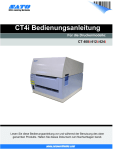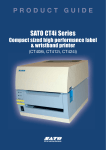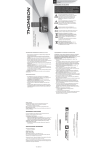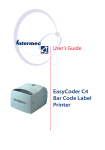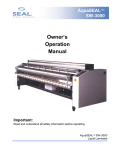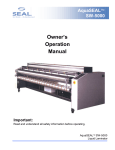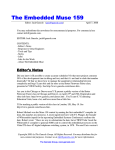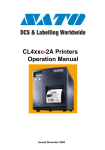Download SATO CT400i Series Instruction manual
Transcript
German Korean CT400i Series Thank you for purchasing the SATO CT400i Series barcode printer. Please read this manual carefully to ensure you understand the CT400i Series functions and how to operate it properly. Chinese Label Printer English Quick Guide CT400iTT Series Thermal transfer type 203dpi/305dpi/600dpi CT400iDT Series Thermosensitive type 203dpi/305dpi/600dpi * Be sure to use SATO genuine parts (labels, ribbons). FCC WARNING English You are cautioned that changes or modifications not expressly approved by the party responsible for compliance could void your authority to operate the equipment. German This device complies with Part 15 of the FCC Rules. Operation is subject to the following two conditions: (1) this device may not cause harmful interference, and (2) this device must accept any interference received, including interference that may cause undesired operation. Korean Chinese This equipment has been tested and found to comply with the limits for a Class B digital device, pursuant to Part 15 of the FCC Rules. These limits are designed to provide reasonable protection against harmful interference in a residential installation. This equipment generates, uses and can radiate radio frequency energy and, if not installed and used in accordance with the instructions, may cause harmful interference to radio communications. However, there is no guarantee that interference will not occur in a particular installation. If this equipment does cause harmful interference to radio or television reception, which can be determined by turning the equipment off and on, the user is encouraged to try to correct the interference by one or more of the following measures: - Reorient or relocate the receiving antenna. - Increase the separation between the equipment and receiver. - Connect the equipment into an outlet on a circuit different from that to which the receiver is connected. - Consult the dealer or an experienced radio/TV technician for help. AC power cord with ferrite core must be used for RF interference suppression. 2 Safety Precautions This section describes how to use the printer safely. Be sure to read it carefully before using the printer. The pictograph means “Should not be done.” What is specifically prohibited is contained in or near the pictograph (The symbol at left means “Disassembly prohibited”). German Caution Ignoring the instructions marked by this symbol and erroneously operating the printer could result in injury or property damage. Example Pictographs The pictograph means “Caution is required.” A specific warning symbol is contained inside this pictograph (The symbol at left is for electric shock). The pictograph means “Must be done.” What is specifically to be done is contained in the pictograph (The symbol at left means “Unplug the power cord from the outlet”). Chinese Warning Ignoring the instructions marked by this symbol and erroneously operating the printer could result in death or serious injury. English Pictographic Symbols This instruction manual and the printer labels uses a variety of pictographic symbols to facilitate safe and correct use of the printer and to prevent injury to others and property damage. The symbols and meanings for them are given below. Be sure to understand these symbols well before reading the main text. Warning Do not put objects inside the printer • Do not insert or drop in metal or burnable objects inside the printer’s openings (cable outlets, etc.). If foreign objects do get inside the printer, immediately turn off the power switch, unplug the power cord from the outlet, and contact a store, dealer, or the Support Center. Using the printer in this condition could cause a fire or electric shock. Do not use other than the specified voltage • Do not use other than the specified voltage. Doing so could result in fire or electric shock. Always ground the connections • Always connect the printer’s ground wire to a ground. Not grounding the ground wire could result in electric shock. Handling of the power cord • Do not damage, break, or modify the power cord. Also, do not place heavy objects on the power cord, heat it, or pull it because doing so could damage the power cord and cause a fire or electric shock. • If the power cord becomes damaged (core is exposed, wires broken, etc.), contact a store, dealer, or the Support Center. Using the power cord in this condition could cause a fire or electric shock. • Do not modify, excessively bend, twist, or pull the power cord. Using the power cord in such a condition could cause a fire or electric shock. When the printer has been dropped or broken • If the printer is dropped or broken, immediately turn off the power switch, unplug the power cord from the outlet, and contact a store, dealer, or the Support Center. Using the printer in this condition could cause a fire or electric shock. Version 1 December 10, 2007 Q02073000 ©2007 SATO CORPORATION Do not use the printer when something is abnormal about it • Continuing to use the printer in the event something is abnormal about it, such as smoke or unusual smells coming from it, could result in fire or electric shock. Immediately turn off the power switch, unplug the power cord from the outlet, and contact a store, dealer, or the Support Center for repairs. It is dangerous for the customer to try to repair it, so absolutely do not attempt repairs on your own. Do not disassemble the printer • Do not disassemble or modify the printer. Doing so could result in fire or electric shock. Ask the store, dealer, or the Support Center to conduct internal inspections, adjustments, and repairs. Korean Do not set on an unstable area • Do not set on an unstable area, such as a wobbly table or slanted area or an area subject to strong vibration. If the printer falls off or topples over, it could injure someone. Do not place containers full of water or other liquid on the printer. • Do not place flower vases, cups, or other containers holding liquids, such as water or chemicals, or small metal objects near the printer. If they are spilled and get inside the printer, immediately turn off the power switch, unplug the power cord from the outlet, and contact a store, dealer, or the Support Center. Using the printer in this condition could cause a fire or electric shock. Regarding the cutter • Do not touch the cutter with your hands or do not put something into the cutter. Doing so could result in an injury. Using the head cleaning fluid • Use of flame or heat around the head cleaning fluid is prohibited. Absolutely do not heat it or subject it to flames. • Keep the fluid out of reach of children to prevent them from accidentally drinking it. If the fluid is drunk, immediately consult with a physician. 3 Safety Precautions Caution German English Do not place in areas with high humidity • Do not place the printer in areas with high humidity or where condensation forms. If condensation forms, immediately turn off the power switch and do not use the printer until it dries. Using the printer while condensation is on it could result in electric shock. Korean Chinese Carrying the Printer • When moving the printer, always unplug the power cord from the outlet and check to make sure all external wires are disconnected before moving it. Moving the printer with the wires still connected could damage the cords or connecting wires and result in a fire or electrical shock. • Do not carry the printer with paper loaded in it. The paper could fall out and cause an injury. • When setting the printer on the floor or a stand, make sure not to pinch your fingers or hands under the printer feet. Power supply • Do not operate the power switch or plug in/unplug the power cord with wet hands. Doing so could result in electric shock. Power cord • Keep the power cord away from hot devices. Getting the power cord close to hot devices could cause the cord’s covering to melt and cause a fire or electrical shock. • When unplugging the power cord from the outlet, be sure to hold it by the plug. Pulling it by the cord could expose or break the core wires and cause a fire or electric shock. • The power cord set that comes with the printer is especially made for this printer. Do not use it with any other electrical devices. Cover • Be careful not to pinch your fingers when opening or closing the cover. Also be careful the cover does not slip off and drop. Thermal head • The thermal head is hot after printing. Be careful not to get burned when replacing paper or cleaning immediately after printing. • Touching the edge of the thermal head with bare hands could result in injury. Be careful not to become injured when replacing paper or cleaning. • The customer should not replace the thermal head. Doing so could result in injury, burns, or electric shock. Opening and closing the thermal head • When opening or closing the thermal head, make sure nothing other than paper gets in it. Debris getting in could cause injury or damage. Loading paper • When loading roll paper, be careful not to get your fingers pinched between the paper roll and the supply unit. • Be careful not to become injured when opening the fanfolded paper loading slot window. When not using the printer for a long time • When not using the printer for a long time, unplug the power cord from the outlet to maintain safety. During maintenance and cleaning • When maintaining and cleaning the printer, unplug the power cord from the outlet to maintain safety. Caution (1) Reproduction in any manner of all or part of this document is prohibited. (2) The contents of this document may be changed without prior notice. (3) Great care has been taken in the preparation of this document, but if any problems, mistakes, or omission are found, please contact the store or dealer where you purchased the printer. 4 Accessories Check German English The following items are packed together with the main unit in the box. Be sure to check to make sure nothing is missing. If something is missing, contact the store or dealer where you purchased the product. ¡ Power cord and AC adapter ¡ Test labels and ribbons ¡ USB cable ¡ Dial adjustment screwdriver ¡ Ribbon adapter Korean Chinese ¡ Quick Guide ¡ Safety manual ¡ Manual (for RoHS) ¡GWP leaflet * Attached to the printer unit. * The test ribbons and ribbon adapter come with the thermal transfer model. The power cord set included with this printer is only for use with this printer. Do not use it with other electrical products. Caution 5 Names of Parts Printer unit [unit exterior] English ¡Window German ¡Label discharge outlet Chinese ¡Top cover ¡Opening lever ¡Front cover Korean ¡Operation panel [Back (USB + LAN interface)] ¡USB interface ¡LAN interface ¡DC input power terminal (Power connector) ¡I/F Cover [Back (USB + RS-232C interface)] ¡USB interface ¡RS-232C interface ¡Interface board The interface can be changed using an optional interface board. ¡DC input power terminal (Power connector) 6 ¡I/F Cover *Handling of an I/F Cover: Please close with an I/F Cover after shutting off a power supply and attaching or removing an I/F board, in case an I/F Cover is opened. Names of Parts When top cover is opened English [For CT400iDT Series] German ¡Thermal head Korean Chinese ¡Paper holder ¡Paper sensor ¡Platen roller ¡Paper holder slide lever [For CT400iTT Series] ¡Ribbon unit ¡Paper holder ¡Paper sensor ¡Platen roller ¡Paper holder slide lever 7 Names of Parts When top cover is opened English [Cutter Type] German ¡Paper sensor Chinese ¡Cutter top knife ¡Paper holder ¡Paper holder slide lever ¡Platen roller Korean (When front cover is open) ¡Cutter bottom knife ¡Cutter unit [Separation Type] ¡Paper holder ¡Paper sensor ¡Platen roller ¡Paper holder slide lever ¡Backing paper discharge outlet (When front cover is open) ¡Separation unit 8 Names of Parts [Operation Panel] ¡ [POWER] lamp English Illuminates (green) when the power switch is on. ¡ [ERROR] lamp Illuminates or flashes (red) when an error occurs. German ¡ [ON LINE] lamp Illuminates (green) when reception is possible. ¡ [ON LINE] key Chinese This is press to stop/restart and to terminate data reception. ¡ [FEED] key Korean This feeds the paper when pressed while the printer is online. ¡ Power switch [When the front cover is opened] ¡Separator connector ¡Cutter connector ¡Error display lamp ¡Adjustment dial ¡Dip switches (DSW1) 9 Loading the Roll Paper [Continuous, Cutter, Linerless types] Press down the opening lever (1) on the right side of the printer to release the lock and open the top cover (2). (2) (1) German English 1 While pressing the paper holder slide lever (1), adjust the paper holder to match the paper size (2). (1) Korean Chinese 2 (2) 3 Load the paper into the paper holder. 4 After pulling out the paper, pass the paper through the paper sensor. Paper sensor 10 Loading the Roll Paper [Continuous, Cutter, Linerless types] 5 Close the top cover. 6 (1) Press the [FEED] key to feed the leading edge of the paper. German English At this time, press on the top where shown by the arrows to close the cover until you hear the lock engage. Chinese (2) Korean (2) Finally, press the [ON LINE] key to bring the printer online. (1) After printing, the thermal head and surrounding area are hot. Be careful not to get burned when replacing paper immediately after printing. Touching the thermal head with bare hands could result in an injury. Caution Be careful not to become injured when replacing paper. Be careful not to pinch your fingers when closing the top cover. 11 Loading fan-folded paper [Continuous, Cutter types] Open the window from the back edge. English 1 Chinese German Window Korean 2 3 12 Press down on the open lever (1) on the right side of the printer to release the lock and then open the top cover (2). Pass the paper through the opened window. (2) (1) Loading fan-folded paper [Continuous, Cutter types] While pressing the paper holder slide lever (1), adjust the paper holder to match the paper size (2). Paper sensor (1) After pulling out the paper, pass it through the paper sensor. Close the top cover. 6 (1) Press the [FEED] key to feed the leading edge of the paper. German (2) Chinese 5 English 4 Korean At this time, press on the top where shown by the arrows to close the cover until you hear the lock engage. (2) (2) Finally, press the [ON LINE] key to bring the printer online. (1) After printing, the thermal head and surrounding area are hot. Be careful not to get burned when replacing paper immediately after printing. Touching the thermal head with bare hands could result in an injury. Caution Be careful not to become injured when replacing paper. Be careful not to pinch your fingers when closing the top cover. 13 Loading Roll Paper [Separator] Press down on the open lever (1) on the right side of the printer to release the lock and then open the top cover (2). 2 Open the front cover forward. 3 While pushing on the [PUSH DOWN] mark on the separator unit, tilt it forward (1) to open the separator unit (2). (2) (1) Korean Chinese German English 1 [PUSH DOWN] mark 4 (1) (2) When the separator unit is opened, the separator bar will automatically open in the direction shown by the arrow. Separator bar 14 Pass the backing paper between the separator unit and the platen roller. Set the backing paper so that it is below the separator plate. German 6 Chinese Peel off labels to expose 15 cm of only the backing paper and then load the paper into the paper holder. After pulling out the paper, pass it through the paper sensor. Korean 5 English Loading Roll Paper [Separator] Platen roller Separator unit Separator plate 7 Press on the [PUSH DOWN] mark on the separator unit in the direction shown by the arrows to close it. If the backing paper is slack, turn the labels to wind it up and remove the slack. [PUSH DOWN] mark 8 Close the front cover. 15 Loading Roll Paper [Separator] Close the top cover. At this time, press on the top where shown by the arrows to close the cover until you hear it lock closed. 10 (1) Press the [FEED] key to feed the leading edge of the paper. Chinese German English 9 (2) Korean (2) Finally, press the [ON LINE] key to bring the printer online. (1) Caution 16 After printing, the thermal head and surrounding area are hot. Be careful not to get burned when replacing paper immediately after printing. Touching the thermal head with bare hands could result in an injury. Be careful not to become injured when replacing paper. Be careful not to pinch your fingers when closing the top cover. Printing Position Adjustment ▲Printing Standard Position English The printing standard position when using labels is the top of the label. The printing standard position when using fan folded paper is the top of the match mark on the back of the fan folded paper. Label German Match mark Chinese Label Paper feed direction Korean Standard position (Vertical position 1 dot) Fan folded paper Match mark Fan folded paper Paper feed direction Standard position (Vertical position 1 dot) If the printing standard position is not at the correct position, open the top cover and used the flat head end of the dial adjustment screwdriver that comes with the printer to adjust the printing standard position. Turn left: Moves the printing position forward relative to the printing direction. Turn right: Moves the printing position backward relative to the printing direction. (Use the dial adjustment screwdriver.) 17 Cut Position Adjustment ▲Label Cut The cut position when using labels is the designated cut position between labels on the blank area (the area where there is only backing paper). English Labels German Backing paper (Fig. 1) Cut position (Fig. 2) Korean Chinese If the cut position is not the prescribed position, open the top cover and use the Philips head end of the dial screwdriver attached to the printer unit to adjust the cut position. Absolutely do not cut on top of the labels because the adhesive will stick to the cutter knife and cause poor cutting. Turn left: Stops the label behind the printing direction. Turn right: Stops the label in front of the printing direction. (Use the dial adjustment screwdriver.) ▲Cutting paper with perforated lines For paper with perforated lines, cutting on or in front of the perforated lines is prohibited. Cutting in those locations could cause the printer to malfunction. If cutting on or in front of the perforated line, use the Philips head end of the dial screwdriver attached to the printer unit to adjust the [OFFSET] so that the cut is behind the perforated line. The following items are specifications for paper that can be used by this printer, so check them before using the printer. (1) Paper thickness (including the backing paper) is 0.08 mm to 0.19 mm. For details contact the store, dealer, or Support Center. (2) Cut accuracy is ±1.5 mm. (3) The cutter unit has a valid cut pitch of 20 to 400 mm. However, the cut size may be restricted depending on the usage conditions. (4) The perforated line +1 mm is the cut prohibited zone (Fig. 1). (5) The folded perforated line +4 mm to +25 mm of fan folded paper is the cut prohibited zone (Fig.2). (6) After adjusting the volume, issue about 2 to 5 labels to stabilize the cut position. 25mm 4mm Folded perforated line Cut prohibited zone Perforated line (Fig. 1) 18 (Fig. 2) Loading the Carbon Ribbon 2 Pull the ribbon unit’s [PULL] mark to pull the ribbon unit forward. (1) (2) German Press down on the open lever (1) on the right side of the printer to release the lock and open the top cover (2). Chinese 1 English [Loading the Carbon Ribbon] Korean [PULL] mark If the carbon ribbon width is over 92 mm and under 76 mm, use Steps 3 to 6 to set the carbon ribbon. For a carbon ribbon with a width greater than 92 mm, load the carbon ribbon directly into the ribbon unit. For a carbon ribbon with a width under 76 mm, use a ribbon adapter to load it into the ribbon unit. Ribbon adapter 19 Loading the Carbon Ribbon [Loading carbon ribbons with a width greater than 92 mm] After setting the carbon ribbon in the right side of the ribbon supply unit (1), press the core guide (2). (1) (2) Chinese German English 3 Korean 4 Ribbon supply unit core guide After setting the ribbon core in the right side of the ribbon windup unit (1), press the core guide (2). (1) (2) 5 Pass the carbon ribbon from the ribbon supply unit beneath the thermal head and to the ribbon windup unit. Affix the carbon ribbon to the ribbon core using tape, etc., and wind it up several times in the direction shown by the turn arrow. Be sure to pass the carbon ribbon between the thermal head and the label restraint. Do not pass it beneath the label restraint. 20 Ribbon windup unit core guide Label restraint Loading the Carbon Ribbon [Loading carbon ribbon with a width under 76 mm] English For carbon ribbon with a width of 76 mm or 59 mm, set the ribbon adapter hooks at the bottom. From this state, turn the hooks in the direction shown by the arrow to set it at the bottom. If the carbon ribbon width is 45 mm, use it in that state. For 76 mm or 59 mm Set the carbon ribbon in the ribbon adapter. For 76 mm or 59 mm 5 6 For 45 mm Set the ribbon adapter in which the carbon ribbon (1) is loaded from the right side of the ribbon supply unit. Set the ribbon adapter in which the ribbon core is set from the right side of the ribbon windup unit (2). Pass the carbon ribbon from the ribbon supply unit under the thermal head and to the ribbon windup unit. Affix the carbon ribbon to the ribbon core with tape, etc., and turn the core several times in the direction shown by the arrow. Korean 4 Chinese German 3 For 45 mm (1) (2) Label restraint 21 Loading the Carbon Ribbon Set the ribbon unit in the top cover and return the cover to its original position. English 7 German Caution Korean Chinese Caution Closing the top cover after closing the ribbon unit could prevent the top cover from closing properly. Always put the ribbon unit in the top cover. For the cutter type, be careful not to cut your hand on the top cutter knife when putting the ribbon unit into the top cover. 8 Set the paper in the paper holder. After pulling out the paper, pass the paper between the paper sensors. 9 Close the top cover. At this time, press on the top where shown by the arrows to close the cover until you hear it lock closed. 10 22 (2) (1) Press the [FEED] key to feed the leading edge of the paper. (2) Finally, press the [ON LINE] key to bring the printer online. Caution Paper sensor (1) The thermal head and surrounding area is hot after printing. When replacing the carbon ribbon immediately after printing, be careful not to get burned. Touching the thermal head with bare hands could result in an injury. Be careful not to get injured when replacing the carbon ribbon. Be careful not to pinch your fingers when closing the top cover. For cutter type printers, be careful not to cut your hands. Connecting to a Computer [Standard Interface] English ¡USB + LAN type USB interface German LAN interface Korean Chinese (1)When using a USB interface, set DSW 1-8 inside the front cover to OFF. When using a LAN interface, set DSW 1-8 inside the front cover to ON. (2)To set the USB interface printing support settings or LAN interface reception mode settings, set DSW 3-2 of the circuit board on the bottom of the printer. For details regarding dip switch settings, refer to [Dip Switch Settings]. /Page 29~31 ¡USB + RS-232C type USB interface RS-232C interface type (1)When using a USB interface, set DSW 1-8 inside the front cover to OFF. When using an RS-232C interface type, set DSW 1-8 inside the front cover to ON. (2)To set the RS-232C interface conditions, set DSW2 of the circuit board on the bottom of the printer. (3)To set the USB interface printing support settings, set DSW 3-2 of the circuit board on the bottom of the printer. For details regarding dip switch settings, refer to [Dip Switch Settings]. /Page 29~31 23 Connecting to a Computer [Extension Interface(Option)] English ¡IEEE 1284 interface German IEEE 1284 interface Korean Chinese (1)When using an IEEE 1284 interface, set DSW 3-1 of the circuit board on the bottom of the printer to ON. (2)To set the printing support for the IEEE 1284 interface setting, set DSW3-2 of the circuit board on the bottom of the printer. For details regarding dip switch settings, refer to [Dip Switch Settings]. /Page 29~31 ¡Wireless LAN2 interface ON (1)(2)(3)(4) Wireless LAN2 interface Wireless LAN2 interface board 24 Dip Switch Table No (1) (2) (3) Operation when the dip switch is ON and the printer power is turned on ((1) to (3)). Not used Wireless LAN2 interface board setting information initialization Wireless LAN2 interface board setting information print/Self-diagnostic print (Prints the setting information, such as IP address, and the wireless LAN2 interface board diagnostic results.) (4) Communication mode OFF: Ad hoc (For wireless LAN operation) ON: Infrastructure When the LAN cable is connected and the power is turned on, the LAN interface starts up. When the LAN cable is not connected and the power is turned on, the wireless LAN interface starts up. Connecting to a Computer German English (1)When using the wireless LAN2 interface, set DSW 3-1 of the circuit board on the bottom of the printer to ON. (2)When setting the wireless LAN2 interface setting to the reception mode, set DSW 3-2 of the circuit board on the bottom of the printer. For details regarding dip switch settings, refer to [Dip Switch Settings]. /Page 29~31 Chinese ¡Bluetooth interface Korean Bluetooth interface The Bluetooth interface board is contained inside the printer and cannot be seen from outside. (1)When using the Bluetooth interface, set DSW 3-1 of the circuit board on the bottom of the printer to ON. For details regarding dip switch settings, refer to [Dip Switch Settings]. /Page 29~31 25 Turning On the Power Plug the AC adapter/power cord into the printer and turn on the power. [Power Setting] Korean Chinese German English 1 2 3 4 When installation is completed, set the power as shown below. Connect the power cord to the AC adapter. The plug of the included power cord is a 3-pronged plug. 3-prong type outlets use one of the prongs as a ground. When the outlet is a 3-prong type, plug the power cord directly into it. Connect the printer → AC adapter → power cord. When plugging the power cord into the printer’s power connector, make sure the power cord connector is oriented properly. When plugging in the power cord to the printer, use one hand to hold the printer while using the other hand to plug in the cord. Plug the included AC adapter into the print and the power cord into the outlet. When the power outlet is the 2-prong type, use the included 2-pronged adapter to plug the power cord into the power outlet. Be sure to connect the ground wire to a ground. Not connecting the ground wire could result in Caution electrical shock. 26 The power cord set included with this printer is only for use with this printer. Do not use it Caution with other electrical products. Turning On the Power [Turning On the Power] English When the power switch is turned on, the POWER lamp will illuminate. (The ONLINE lamp also illuminates.) Check to make sure this happens. POWER lamp ERROR lamp ONLINE lamp [ONLINE] key Power switch German Turn on the power switch at the front of the printer. Switch it to the “ ” symbol. Chinese [FEED] key Caution Korean Do not operate the power switch or plug in/unplug the power cord with wet hands. Doing so could result in electric shock. [If you think something is wrong...] When preparation does not go well as it has before, the ONLINE LINE lamp or the POWER lamp will not illuminate. When preparation is not performed properly, the ERROR lamp will illuminate or flash. If the ERROR lamp illuminates or flashes, redo the preparation. [Turning Off the Power] After making sure the printer is operating properly, turn off the power. Do not suddenly turn off the power before making sure the printer is ready to have the power turned off. ▲Check the following before turning off the power. Press the [ONLINE] key and confirm the ONLINE lamp has turned off. After the ONLINE lamp turns off, turn off the power. Switch the switch to the “ ” symbol. 27 Printing Operation Confirmation and Error Number Display [Printer Status Print] Korean Chinese German English This prints the status of the printer. The current settings information is printed, so check the settings printout. 1 Turn on the power while pressing the [FEED] key. 2 The buzzer will sound, so then press the following key. [ON LINE] key [FEED] key Press the [ON LINE] key to print a large size. Press the [FEED] key to print a small size. Pressing the [FEED] key during printing will stop/restart printing. 3 The printer setting information is printed out. Check if the printed information is the settings values. (1)(2)(3)(4)(5)(6)(7)(8) 28 Printing Operation Confirmation and Error Number Display English [Dip Switch Settings] Suitable settings have been made to match the printer’s operating environment, but in the event the settings are different, please reset the dip switches. German * A detailed explanation of the dip switches is given on the explanation sticker affixed to the printer. ¡Dip Switch Settings Table DSW1 (Inside the front cover) Chinese USB + LAN type Printing Method DSW1-4 Dump Mode DSW1-7 Direct thermal OFF Disable OFF Thermal transfer ON Enable ON Head check DSW1-5 Interface Change DSW1-8 Disable OFF USB OFF LAN ON Enable ON VR1 adjustment selection DSW1-6 Offset adjustment OFF Print density adjustment ON Korean Mode Change DSW1-1 DSW1-2 DSW1-3 Continuous OFF OFF OFF Tear off ON OFF OFF Cutter OFF ON OFF Separator ON ON OFF Liner less OFF OFF ON Partial cut ON ON ON Font download OFF ON ON USB + RS-232C type DSW1-7 Mode Change DSW1-1 DSW1-2 DSW1-3 Printing Method DSW1-4 Dump Mode OFF OFF OFF OFF Disable OFF Continuous Direct thermal ON OFF OFF ON Tear off Thermal transfer ON Enable OFF ON OFF DSW1-5 Interface Change DSW1-8 Cutter Head check ON ON OFF OFF USB OFF Separator Disable OFF OFF ON ON ON Liner less RS-232C Enable ON ON ON Partial cut VR1 adjustment selection DSW1-6 ON ON OFF Font download OFF Offset adjustment Print density adjustment ON * The head check is a head disconnection guideline and is not a function warranted for the barcode reader. Check the barcode reader periodically. 29 Printing Operation Confirmation and Error Number Display ¡Dip Switch Settings Table DSW2 (RS-232C Interface Settings) Only for the USB + RS-232C type German English To change the dip switch DSW2 settings to make the RS-232C interface settings, set them as shown below. (1) Turn off the printer power and disconnect the power cord. (2) Disconnect the connected interface cable. (3) Remove the paper set in the printer. (4) Open the cover on the bottom of the printer. Korean Chinese Make the ON/OFF setting for dip switch DSW2 that is on the circuit board and then switch to the RS-232C interface settings. ON (1)(2)(3)(4)(5)(6)(7)(8) No. (1) Function Data bit length (2) (3) Parity bit (4) Stop bit (5) (6) Baud rate (7) (8) 30 Communication protocol Explanation OFF: 8 bit ON: 7 bit DSW2-2 DSW2-3 OFF OFF OFF ON ON OFF ON ON Parity bit None Even number Odd number Not used OFF: 1 bit ON: 2 bit Baud rate DSW2-5 DSW2-6 OFF OFF 9600bps OFF ON 19200bps ON OFF 38400bps ON DSW2-7 ON DSW2-8 57600bps OFF OFF OFF ON ON OFF ON ON Protocol READY/BUSY XON/XOFF Status 3 return Status 4 return Printing Operation Confirmation and Error Number Display Chinese German English ¡Dip Switch Settings Table DSW3 (Standard/Extension Interface Settings) To change the dip switch DSW3 settings to make the standard/extension interface change, set them as shown below. (1) Turn off the printer power and disconnect the power cord. (2) Disconnect the connected interface cable. (3) Remove the paper set in the printer. (4) Open the cover on the bottom of the printer. Make the ON/OFF setting for dip switch DSW3 that is on the circuit board and then switch the standard/extension interface settings. Korean ON (1)(2) USB + LAN type No. (1) (2) Function Not used Interface settings Explanation Normally OFF USB interface (DSW1-8 OFF) DSW3-2 Printing port OFF SATO port ON Standard printing port LAN interface (DSW1-8 ON) DSW3-2 Reception mode OFF Periodic response status ON ENQ response status USB + RS-232C type No. (1) Function Standard/extension Interface change (2) Interface settings Explanation Standard interface When DSW1-8 is OFF, USB interface When DSW1-8 is ON, RS-232C interface ON : Extension interface (option) USB interface (DSW1-8 OFF, DSW3-1 OFF) DSW3-2 Printing port OFF SATO port ON Standard printing port IEEE 1284 interface (DSW3-1 ON) DSW3-2 Printing port OFF SATO port ON Standard port Wireless LAN2 interface (DSW3-1 ON) DSW3-2 Reception mode Periodic response status OFF ON ENQ response status OFF : 31 Printing Operation Confirmation and Error Number Display ¡Error Messages English Error Code or write count overflow. Contact the store, dealer, or support center. Defective circuit board Contact the store, dealer, or support center. 3 EEPROM error Contact the store, dealer, or support center. Chinese Thermal head is disconnected 4 5 Top cover is not locked. 6 The paper is dead. 7 or broken. Sensor type does not match, or sensor level does not match. The cutter is not connected, or 8 9 A b c d r 32 Resolution Method 2 Korean German 0 Cause FLASH ROM read/write overflow the cutter is not operating normally.*1 Contact the store, dealer, or support center. Press on both sides of the top of the top cover until you hear the cover lock in place. Load new paper Contact the store, dealer, or support center. Contact the store, dealer, or support center. *1 For cutter, linerless, ad partial cutter types. The ribbon is dead. or ribbon is broken.*2 Correctly load the ribbon. The amount of data sent from Turn the power off and on again. Adjust the the computer is too high. computer’s software data amount to match the There is a problem with the computer’s communication conditions. If this does not resolve communication conditions settings. the error, check the communication conditions. Abnormal read/write from the RFID tag. *2 For thermal transfer printers Set a new RFID. Basic Specifications Sheet capacity Roll paper Fan-folded paper Carbon ribbon Width Length Base material thickness Color Winding direction Label feed Dimensions Korean Chinese German English CT400i Series Model name CT408iDT/CT408iTT CT412iDT/CT412iTT CT424iDT/CT424iTT Printing method Thermal transfer (DT)/ Thermosensitive (TT) Head density 8-dot/mm (203 dpi) 12-dot/mm (305 dpi) 24-dot/mm (600 dpi) Printing effective range 104 mm wide x 400 mm pitch Printing is not possible for 1.5 mm from both edges, and printing is not possible in the I-mark range. Maximum 6 inchs (Approx. 150 mm/s) Maximum 4 inchs (Approx. 100mm/s) Max. 3 inchs (Approx. 75 mm/sec) Printing speed Note: However, there are times when there are restrictions depending on the printing layout, paper, and type of carbon ribbon. Paper Only use paper manufactured and specified by SATO. 0.08 to 0.19 mm Paper thickness Roll paper, fan-folded paper Shape type Standard Width: 25 to 115 mm (28 to 118 mm) Label size (Backing paper and Pitch: 15 to 397 mm (18 to 400 mm) thick paper size) Tear off Width: 25 to 115 mm (28 to 118 mm) Pitch: 27 to 397 mm (30 to 400 mm) Separated Width: 25 to 115 mm (28 to 118 mm) Pitch: 20 to 120 mm (23 to 123 mm) Cutter Width: 25 to 115 mm (28 to 118 mm) Pitch: 20 to 397 mm (23 to 400 mm) linerless Width: 25 to 118 mm Pitch: 23 to 123 mm Partial cut Width: 25 to 115 mm (28 to 118 mm) Pitch: 20 to 397 mm (23 to 400 mm) There may be restrictions depending on the number issued and the paper size and type. However, there may be restrictions on size depending on the usage conditions. Max. outside diameter: 110 mm (Approx. 50 m/roll) Using 40 mm paper core Surface wound (However, linerless is for surface wound only) Max. folded height: 100 mm (Supplied from outside the printer.) Refer to “Fan-folded Paper Settings.” / page 12 Only use carbon ribbon manufactured and specified by SATO. 45, 59, 76, 92, 111mm The carbon ribbon width should be wider than the paper being used. 100 m/roll 4.5 µm Black (standard) However, colored ribbon is available. Surface winding Continuous, tear off, separated, cutter, linerless, partial cut 198 W × 247 D × 181 H mm (standard) 33 Basic Specifications German English Weight Power supply AC adapter Input voltage Output voltage Power consumption Chinese Environmental conditions Korean External interface Standard interface Extension interface Operation panel Keys Switches lamp Adjustment dials Sensor Printing format 34 3.0 kg (standard) Excluding AC adapter,battery AC 100 to 240V (1.5A) 50/60 Hz DC 25V (2.0A) Print ratio 30% 180VA Maximum 280VA During standby 30VA 120W 180W 15W Operation ambient temperature: 5 to 35°C Humidity: 30 to 80% (However, no dew formation) Storage ambient temperature : -5 to 60°C Humidity: 30 to 90% (However, no dew formation) Excluding paper and carbon ribbon USB + LAN type USB (Full Speed) LAN (10BASE-T/100BASE-TX automatic switching) USB + RS-232C type USB (Full Speed) RS-232C USB + RS-232C type Parallel (IEEE 1284) Wireless LAN2 (LAN: 10BASE-T/100BASE-TX automatic switching, Wireless LAN: IEEE 802.11 b/g) Bluetooth (Bluetooth Specification Ver. 1.1 Class 2) LINE, FEED POWER switch, DIP switch POWER, ONLINE, ERROR, 7SEG lamp Paper sensor adjustment, printing position adjustment, printing density adjustment, tear off/separated/cutter stop position adjustment. However, printing density adjustment and tear off/separated/cutter stop position adjustment are switched using DSW1-6. Paper sensor reflection type, transparent type Transfer from host (computer)(with format registration function) OCR-A 44×66 dots (alphanumeric, symbol) OCR-B 60×72 dots (alphanumeric, symbol) 2D Barcode Composite Symbol Composite Symbol(JAN/EAN, UPC-A/UPC-E, GS1-128, GS1 DataBar(RSS)) Magnification Vertical ×1 to ×12, horizontal ×1 to ×12 (characters) 1 to 12L (barcode) Rotation Characters Barcode Barcode ratio Self-diagnostic function Noise standard Emitted noise Options Chinese UPC-A/UPC-E, JAN/EAN, CODE39, CODE93, CODE128, GS1-128(UCC/EAN-128), CODABAR(NW-7), ITF, Industrial 2of5, Matrix 2of5, BOOKLAND, MSI, POSTNET, GS1 DataBar(RSS) QR Code, Micro QR, PDF417, Micro PDF, MAXI Code, GS1 DataMatrix(ECC200) Korean Barcode XU 5 × 9 dots (alphanumeric, symbol) XS 17 × 17 dots (alphanumeric, symbol) XM 24 × 24 dots (alphanumeric, symbol) XB 48 × 48 dots (alphanumeric, symbol) XL 48 × 48 dots (alphanumeric, symbol) Outline font (alphanumeric, symbol) OCR-A 22×33 dots OCR-A 15×22 dots (alphanumeric, symbol) (alphanumeric, symbol) OCR-B 20×24 dots OCR-B 30×36 dots (alphanumeric, symbol) (alphanumeric, symbol) German Contained fonts Standard English Basic Specifications 0°, 90°, 180°, 270° Parallel 1, Serial 1, Parallel 2, Serial 2 1:2, 1:3, 2:5, Free specification Head check, head/cover open, paper end, ribbon end, test print FCC, CE, CCC, MIC (If differs in each destination) Separation unit, cutter unit, Linerless unit, RFID unit, interface board (Parallel (IEEE 1284), Wireless LAN2 (LAN: 10BASE-T/100BASE-TX automatic switching, Wireless LAN: IEEE 802.11 b/g), Bluetooth) Notice regarding the registered trademarks and trademarks of other companies QR Code is a registered trademark of DENSO WAVE INCORPORATED. 35





































